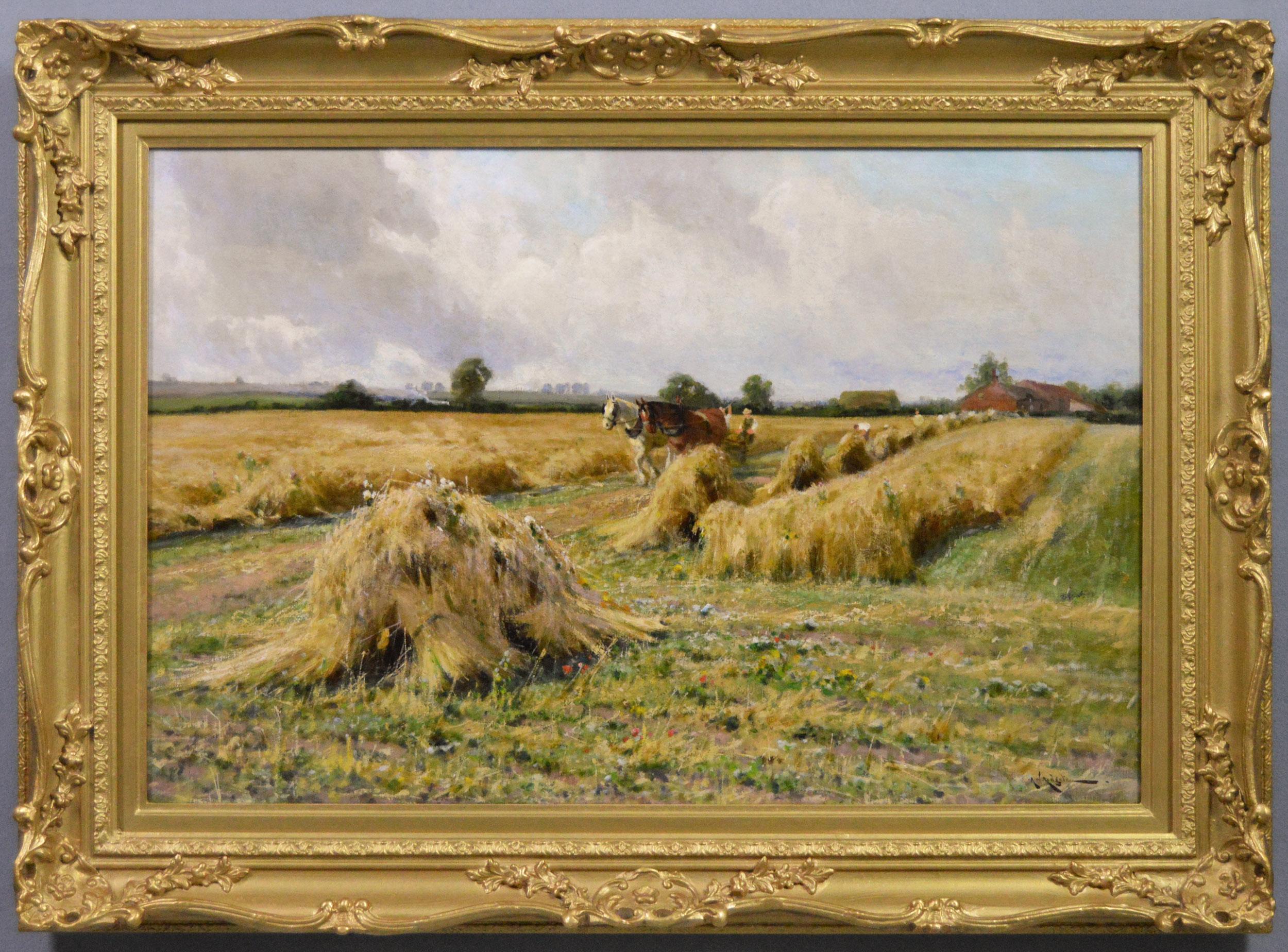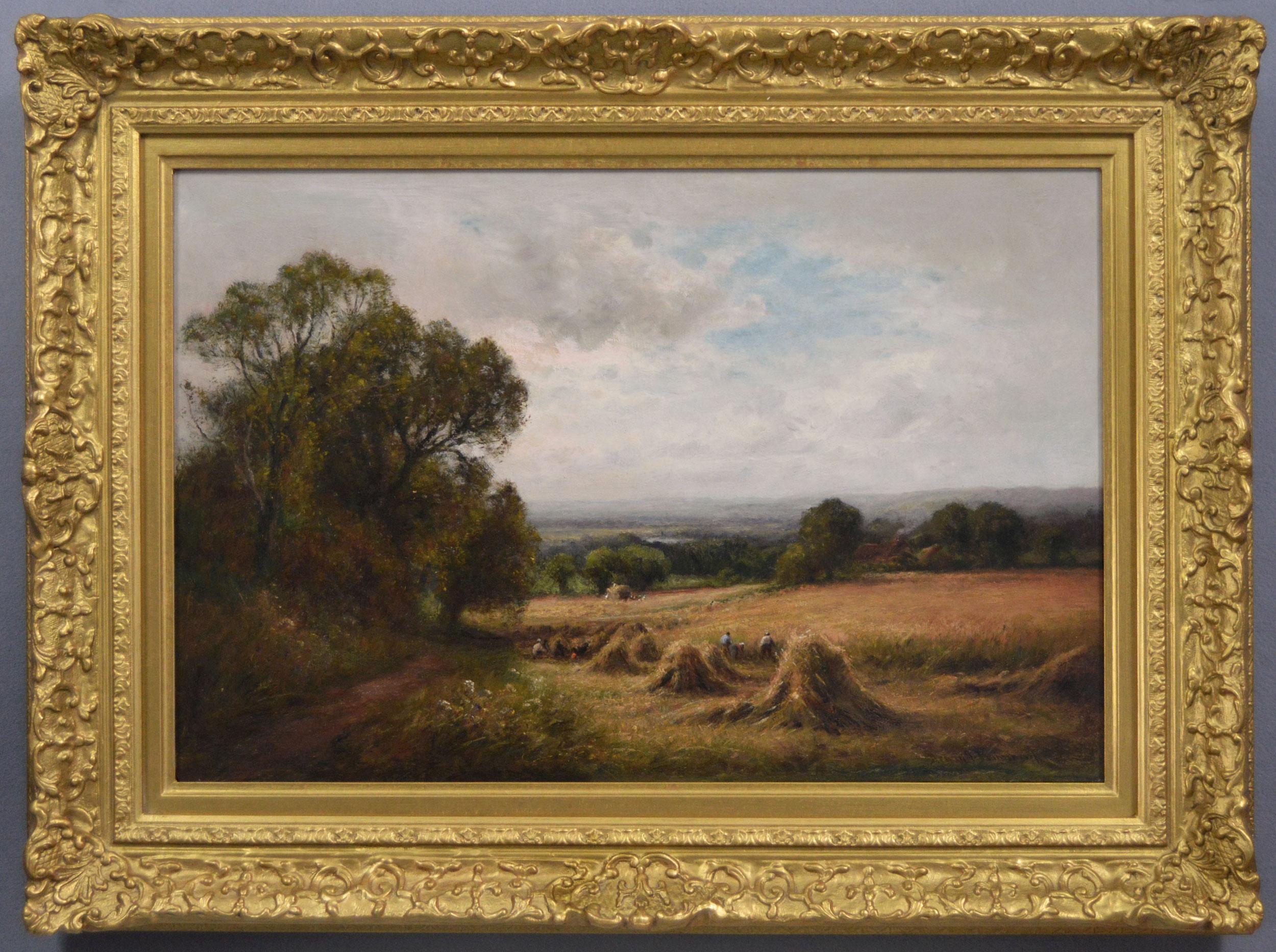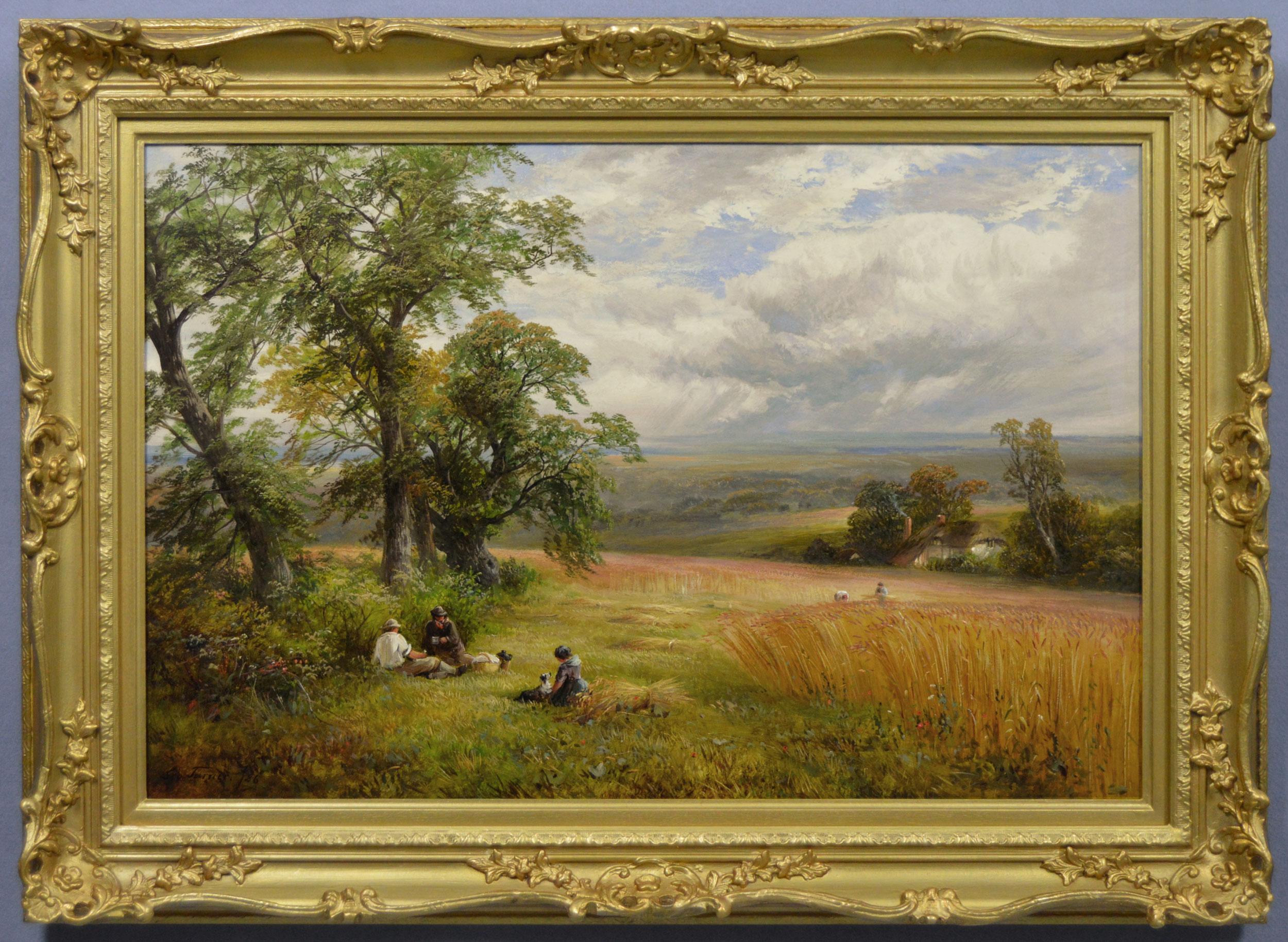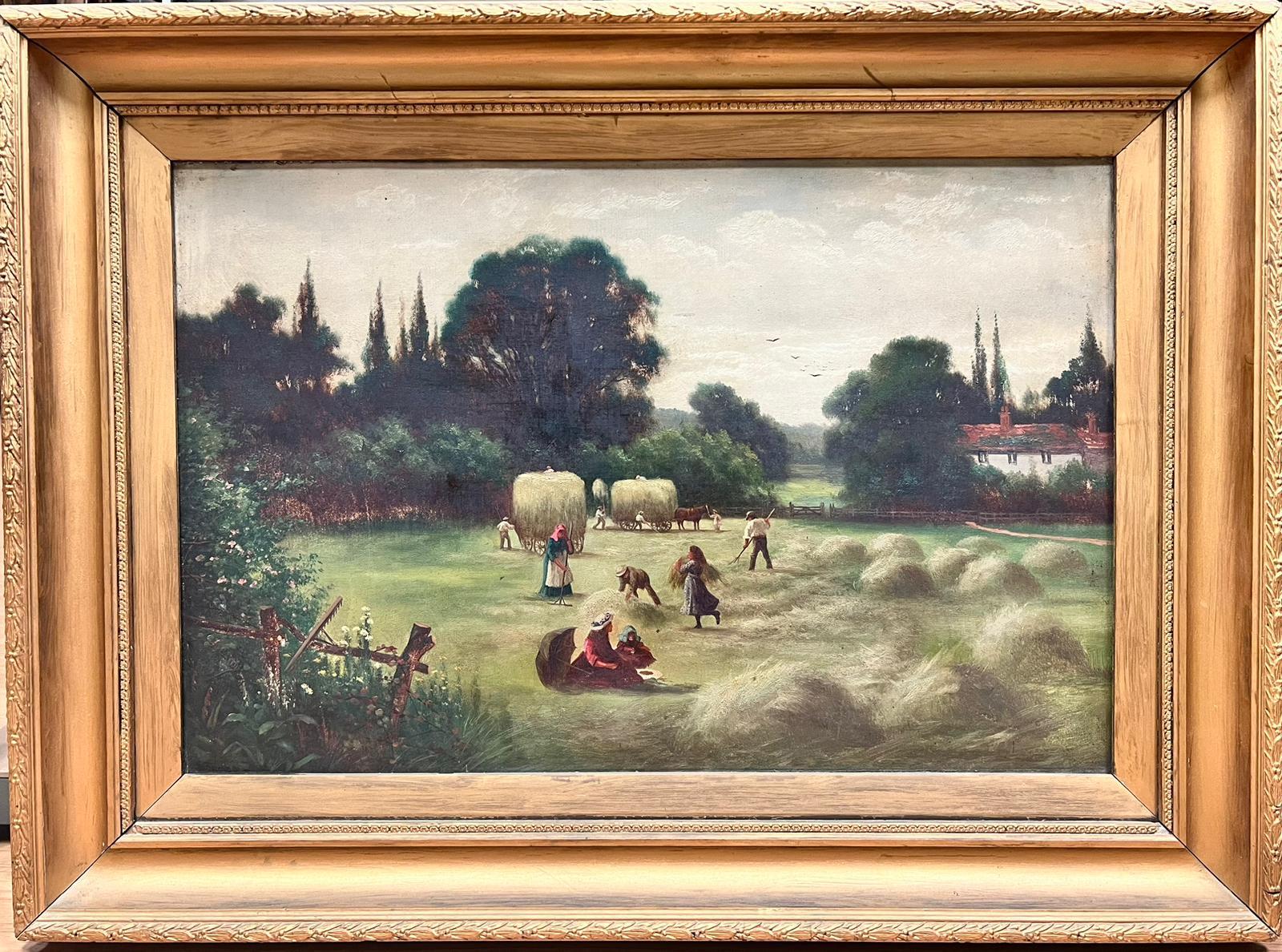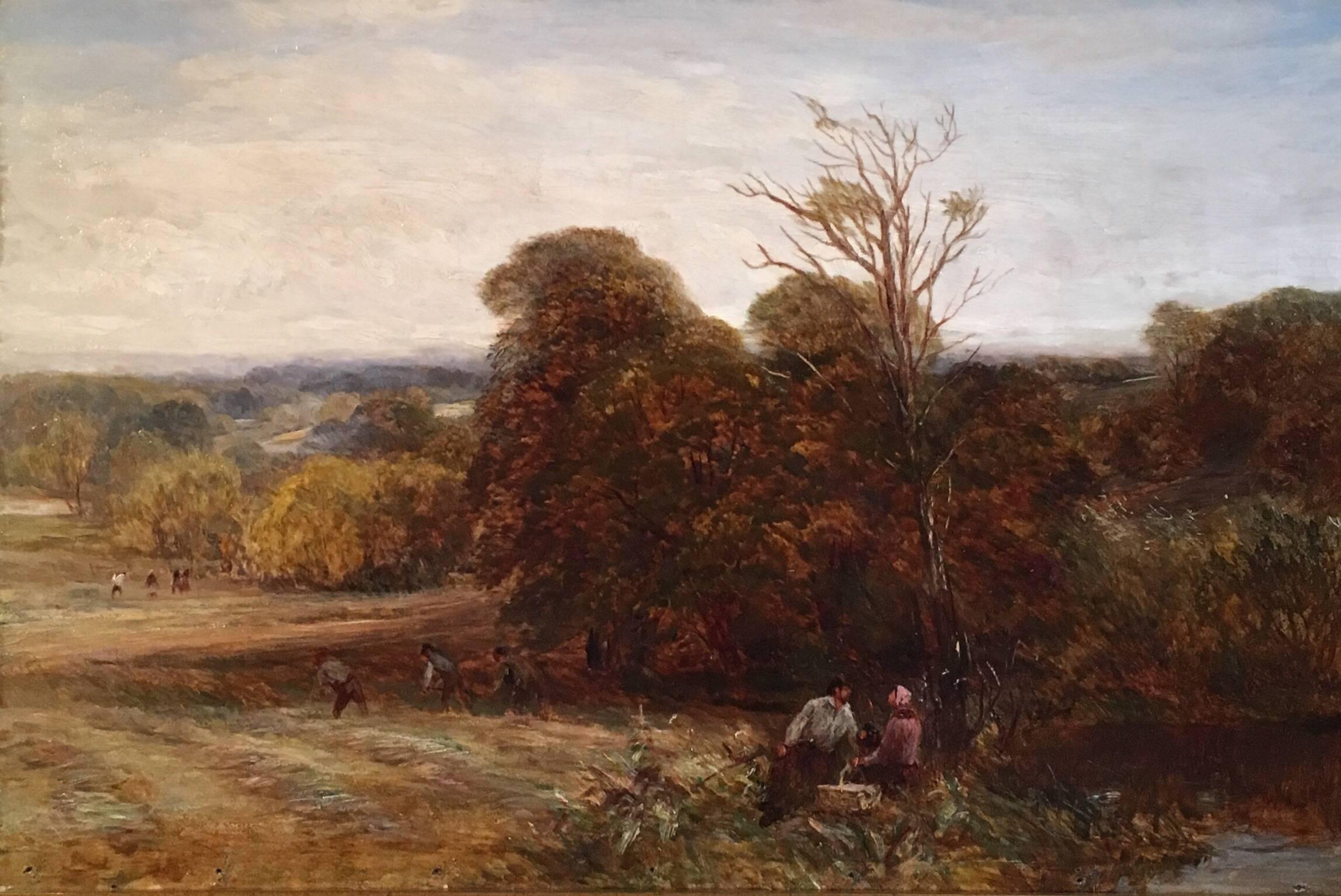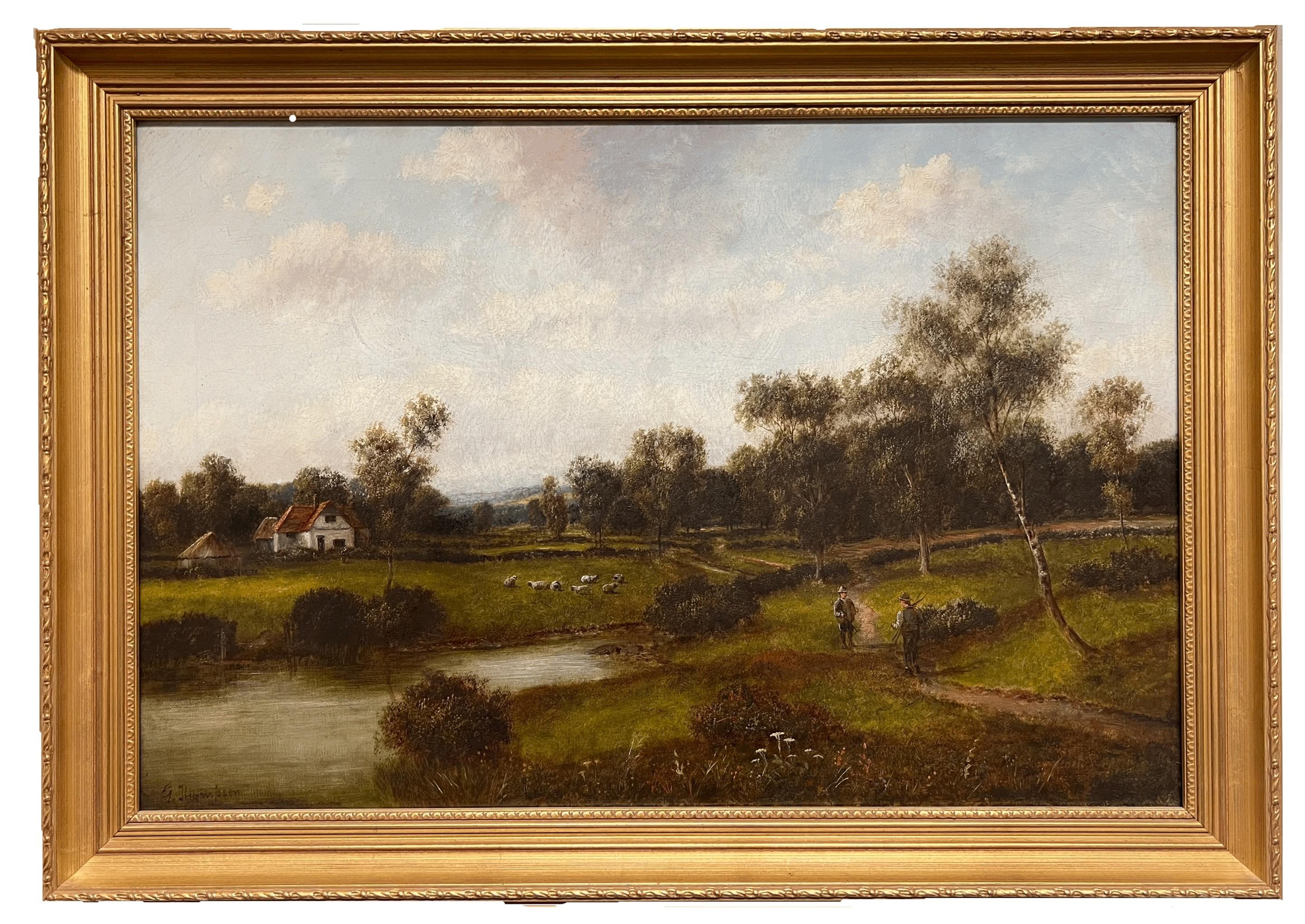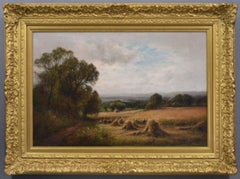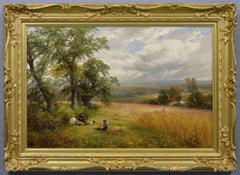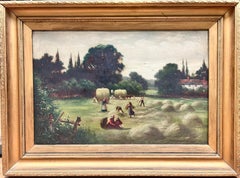Items Similar to Harvest Landscape - British 19th century art Victorian landscape oil painting
Want more images or videos?
Request additional images or videos from the seller
1 of 15
Harvest Landscape - British 19th century art Victorian landscape oil painting1883
1883
$6,169.17
$7,711.4620% Off
£4,400
£5,50020% Off
€5,227.91
€6,534.8820% Off
CA$8,419.14
CA$10,523.9320% Off
A$9,375.47
A$11,719.3420% Off
CHF 4,879.42
CHF 6,099.2720% Off
MX$115,598.44
MX$144,498.0520% Off
NOK 62,143.08
NOK 77,678.8520% Off
SEK 58,408.47
SEK 73,010.5920% Off
DKK 39,006.66
DKK 48,758.3220% Off
Shipping
Retrieving quote...The 1stDibs Promise:
Authenticity Guarantee,
Money-Back Guarantee,
24-Hour Cancellation
About the Item
This lovely British Victorian landscape oil painting is by attributed to artist Keeley Halswelle. Painted in 1883 it is a large harvest scene with wheat sheaves in a field in the foreground and labourers working. The field is lined with tress and there are dwellings beyond, all beneath a summer's sky. A superb Victorian landscape and an excellent example of Halswelles' work.
Signed and dated 1883.
Provenance. London estate.
Condition. Oil on canvas, 36 inches by 28 inches unframed and in good condition.
Frame. Housed a complementary frame, 43 inches by 35 inches framed and in good condition.
Keeley Halswelle (1831-1891) was an English artist. Halswelle was born John Keeley Haswelle, son of David and Elizabeth Haswelle, at Richmond, Surrey. At an early age he contributed drawings to the Illustrated London News and took up book illustration. Work for the Illustrated Shakespeare of Robert Chambers took him to Edinburgh, where he found a good friend in William Nelson, the publisher. In 1863 he is listed as living at Bellfield House in Duddingston Village on the southern outskirts of Edinburgh. In 1869 Halswelle left England for Italy, and during the next few years concentrated on subjects found there. He was elected a member of the Institute of Painters in Oil Colours in 1882. Halswelle lived in his later years at Stoner House, Steep, near Petersfield in Hampshire, where he was a ruling councillor of the Primrose League. In 1857 a painting of his was exhibited at the Royal Scottish Academy, and in 1866 Halswelle was elected associate. The Roba di Roma, exhibited at Burlington House, gained a prize at Manchester; but the popular work of this period was Non Angli sed Angeli, painted in 1877, which was exhibited at the Royal Scottish Academy in 1878. Halswelle in later life added to his reputation, as a landscapist. A painting in oil of the River Thames above Maidenhead was included in Henry Tate's gift to the nation and went to the Millbank Gallery. In 1884 some of his views of the Thames, Six Years in a Houseboat, were shown in London; and he wrote a book under the same title. He died of pneumonia in Paris in 1891 and was buried at Steep.
About the Seller
5.0
Platinum Seller
Premium sellers with a 4.7+ rating and 24-hour response times
1stDibs seller since 2018
450 sales on 1stDibs
Typical response time: <1 hour
- ShippingRetrieving quote...Shipping from: London, United Kingdom
- Return Policy
Authenticity Guarantee
In the unlikely event there’s an issue with an item’s authenticity, contact us within 1 year for a full refund. DetailsMoney-Back Guarantee
If your item is not as described, is damaged in transit, or does not arrive, contact us within 7 days for a full refund. Details24-Hour Cancellation
You have a 24-hour grace period in which to reconsider your purchase, with no questions asked.Vetted Professional Sellers
Our world-class sellers must adhere to strict standards for service and quality, maintaining the integrity of our listings.Price-Match Guarantee
If you find that a seller listed the same item for a lower price elsewhere, we’ll match it.Trusted Global Delivery
Our best-in-class carrier network provides specialized shipping options worldwide, including custom delivery.More From This Seller
View AllHarvest Time in Yorkshire - British art 19th century landscape oil painting
By John Horace Hooper
Located in London, GB
This lovely Victorian landscape oil painting on canvas is by noted exhibited British artist John Horace Hooper. Hooper was particularly known for his landscapes and was fond of the s...
Category
1880s Realist Landscape Paintings
Materials
Oil
Landscape with Cattle - Surrey - British Victorian art 19th century oil painting
By George William Mote
Located in London, GB
This charming Victorian landscape oil painting is by noted prolific exhibited British artist George William Mote. Mote was very fond of painting landscapes in Surrey and this is a pa...
Category
1880s Victorian Landscape Paintings
Materials
Oil
Landscape with Cottages and Sheep - British Victorian 1850's art oil painting
By William Henry Crome
Located in London, GB
This superb oil on panel painting is by British Victorian artist William Henry Crome, son of artist John Crome, founder of the Norwich School. Painted circa 1850 the painting depicts...
Category
19th Century Victorian Landscape Paintings
Materials
Oil
Cattle and Drover in a Landscape - British Victorian art landscape oil painting
Located in London, GB
This gorgeous oil on canvas Victorian Old Master painting is by British artist Henry Jutsum. Painted circa 1850 the painting depicts a drover on horse back bringing up the rear behin...
Category
19th Century Old Masters Landscape Paintings
Materials
Oil
Harvest Time - British Victorian exhibited art figurative landscape oil painting
Located in London, GB
This superb large exhibited British Victorian oil painting is by noted artist Thomas Falcon Marshall. Painted in 1849 it was exhibited at the Royal Academy London that year. This lar...
Category
19th Century Victorian Portrait Paintings
Materials
Oil
Cadzow Forest Scotland - British mid 19thC art Scottish landscape oil painting
By Samuel Bough
Located in London, GB
This lovely British Victorian landscape oil painting is by noted artist Sam Bough. It was painted in 1855 after Bough had moved to Hamilton Lanarkshire in Scotland to focus on painting landscapes alongside fellow artist Alexander Frazer. The location is the ancient forest of Cadzow in Lanarkshire which they both favoured. The landscape is of a rough path through ancient oaks heading towards more dense forest with white cattle grazing to the right. A superb balanced composition and an excellent example of Bough's skill in landscape painting.
Signed lower left and dated 1855.
Provenance. Christie's stencil verso 519GG.
James Bourlet & Sons label verso.
Condition. Oil on canvas, 28 inches by 18 inches unframed and in good condition.
Frame. Housed in an ornate gilt Victorian frame, 35 inches by 25 inches framed and in good condition.
Samuel Bough RSA (1822–1878) was an English-born landscape painter who spent much of his career working in Scotland. He was born the third of five children in Abbey Street, Carlisle in northern England, the son of James Bough (1794-1845), a shoemaker, and Lucy Walker, a cook. He was raised in relative poverty, but with a keen encouragement in the arts. He was self-taught but mixed with local artists such as Richard Harrington and George Sheffield, and was strongly influenced by the work of Turner. After an unsuccessful attempt to live as an artist in Carlisle he obtained a job and as a theatre scenery painter in Manchester in 1845, later also working in Glasgow in the same role. Encouraged by Daniel Macnee to take up landscape painting he moved to Hamilton from 1851-4 and worked there with Alexander Fraser. In 1854 he moved to Port Glasgow to work on his technique of painting ships and harbours. His paintings were noted for their sensitivity to atmosphere and light, were often of cloudy shorelines and busy harbours. He also began supplementing his income by illustrating books, before moving to Edinburgh in 1855. On coming to Edinburgh he lived in a terraced house at 5 Malta Terrace in the Stockbridge area of the city. Following Turner's example, he became a skil ful painter of seaports. He was buried in Dean Cemetery Edinburgh on 23 November 1878. The grave bears a bronze medallion of his head by William Brodie...
Category
Mid-19th Century Realist Landscape Paintings
Materials
Oil
$8,917 Sale Price
20% Off
You May Also Like
19th Century landscape oil painting of a harvest
Located in Nr Broadway, Worcestershire
Arthur Walker Redgate
British, (1860-1906)
The Harvesters
Oil on canvas, signed
Image size: 19.25 inches x 29.25 inches
Size including frame: 27 inches x 37 inches
A pleasing lands...
Category
19th Century Landscape Paintings
Materials
Canvas, Oil
19th Century Sussex landscape oil painting of a harvest
By Henry John Kinnaird
Located in Nr Broadway, Worcestershire
Henry John Kinnaird
British, (1861-1929)
View near Cooksbridge, Sussex
Oil on canvas, signed & further inscribed verso
Image size: 15.5 inches x 23.5 inches
Size including frame: 23 inches x 31 inches
A pleasing landscape scene of a harvest near Cooksbridge, Sussex by Henry John Kinnaird. Figures are shown harvesting a crop in the foreground; whilst in the field beyond others stack sheaves onto a hay cart. A cottage and other buildings can be seen nestled amongst trees to the right. Cooksbridge is a village situated in the parish of Hamsey in Sussex a short distance from Lewes. It sits on the edge of the South Downs National Park, England’s newest national park which was designated in 2010.
Henry John Kinnaird was a landscape artist born on 7 June, 1861 at Old Church, St Pancras in London. He was the eldest son of Francis Henry Kinnaird (1836-1916), who was an artist and his wife Charlotte née Lee. His brother Francis Joseph ‘Wiggs’ Kinnaird (1875-1915) also became an artist. Both were probably tutored by their father as their style and subject matter are similar, but Henry is also known to have taught his brother art. He spent his time on painting trips around the country and visited areas such as Buxton in Derbyshire where he met his future wife.
He made his debut at the Royal Society of British Artists in 1880 from his parents address at 98 Brecknock Road, Islington with a work entitled ‘In the Green Woods, near Buxton’. By the time of his marriage to Alice Mary Leyland on 6 Feb, 1883 at Buxton he had established himself as a full time artist. The couple spent their early married life at 38 Leighton Road, Camden and had 2 children together.
In 1886, he began exhibiting at the Royal Academy where he continued to show his work over the years. He moved to Chingford, Essex around 1887 where he was inspired by the views in his locality. Kinnaird painted in both oils and watercolours in a broad, naturalistic style similar to John Horace Hooper. Many of his works are of harvest scenes such as this fine example.
After the death of his wife Alice in 1890, he married Mary Helen Cooke on 6 September, 1892. The couple went on to have 2 children. By 1901, he had relocated with his family to Worthing in Sussex where he lived at Rusholme on Homefield Road. After staying there for a few more years he moved to Elm Croft, Burpham, Arundel before moving to Ringmer near Lewes in Sussex.
He spent the final years of his life living at The Old Cottage in Ringmer, where he died on 26 April, 1929. An example of his work is held by Chelmsford Museum.
Presentation: The work is housed in a new English made gilt frame which is in excellent condition.
Condition: As with all of our original antique oil paintings, this work is offered in ready to hang gallery condition, having just been professionally cleaned, restored and revarnished.
© Benton Fine Art
Category
19th Century Landscape Paintings
Materials
Canvas, Oil
19th Century landscape oil painting of a harvest in Derbyshire
By George Turner
Located in Nr Broadway, Worcestershire
George Turner
British, (1843-1910)
Harvesting near Barrow-on-Trent
Oil on canvas, signed & dated (18)86, further inscribed verso
Image size: 19.25 inches x 29.25 inches
Size includ...
Category
19th Century Victorian Landscape Paintings
Materials
Canvas, Oil
Rural Harvest Scene Gathering Hay Farming Landscape 19th Century English Oil
Located in Cirencester, Gloucestershire
The Harvest
English School, late 19th century
oil on canvas, framed
framed: 28 x 38 inches
canvas: 20 x 30 inches
provenance: private collection, Suffolk, England
condition: very goo...
Category
Late 19th Century Victorian Figurative Paintings
Materials
Oil
$2,154 Sale Price
30% Off
The Harvest, Victorian Oil Painting
Located in Cirencester, Gloucestershire
The Harvest, Victorian Oil Painting
English School, 19th Century
Oil painting on canvas, framed
Framed size: 18 x 26 inches
Fine Victorian oi...
Category
19th Century Victorian Landscape Paintings
Materials
Oil
$1,766 Sale Price
30% Off
Traditional 19th Century English Victorian Signed Oil Painting Rural Landscape
Located in Cirencester, Gloucestershire
The Country Pathway
English School, 19th century
signed 'G. Thompson'
oil on canvas, framed
framed: 20 x 28 inches
canvas: 16 x 24 inches
Provenance: private collection, England
Cond...
Category
19th Century Victorian Landscape Paintings
Materials
Oil
